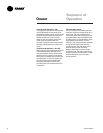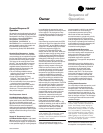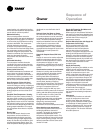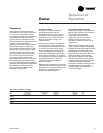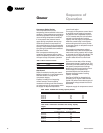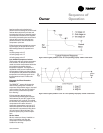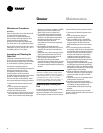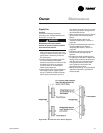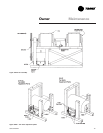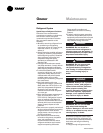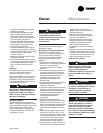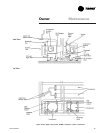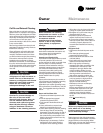
100 SCXG-SVX01B-EN
Figure O-M-2. Fan Belt Adjustment.
Figure O-M-3. Belt Tension Gauge.
Fan Bearings
The opposite drive end bearing is a
special bearing with close tolerance fit of
balls and races. Replace this bearing with
the same part number as the original
bearing.
Fan Belt Tension
Note: Check fan belt tension at least twice
during the first days of new belt operation
since there is a rapid decrease in tension
until belts are run-in.
Proper belt tension is necessary to
endure maximum bearing and drive
component life and is based on fan brake
horsepower requirements. If frayed or
worn, replace belts in matched sets.
Measuring Belt Tension
Measure fan belt tension with a
Browning, Gates, or equivalent belt
tension gauge. Determine deflection by
dividing the belt span distance (in inches)
by 64. See Figure O-M-2.
Recommended belt tension range values
are on the unit fan scroll. The belt tension
label is on the top right-hand corner of the
fan scroll. See Figure O-M-4.
Follow the procedure below to measure
belt tension.
1. Measure belt span between centers of
sheaves and set the large “O” ring of
the tension gauge at
1
/
64
inch for each
inch of belt span.
2. Set the load “O” ring at zero.
3. Place the large end of the gauge at the
center of the belt span. Press down until
the large “O” ring is even with the top
of the belt line or the next belt as in
Figure O-M-2. Place a straight edge
across the sheaves as a reference
point. See Figure O-M-1 on page 99.
4. Remove the gauge. Note that the load
“O” ring now indicates a number on the
plunger scale. This number represents
pounds of force required to deflect the
belt.
5. Check the reading from step 4 against
the values given on the unit fan scroll. If
necessary, readjust belt tension.
Deflection = Belt Span/64
Owner
Maintenance
Adjusting Belt Tension
To adjust belt tension refer to Figure O-M-
2 and perform the following procedure:
1. Loosen bolts A, B, and E on both sides
of the sliding motor base. See Figure O-
M-4.
2. Loosen nuts C and D (as required for
motor horsepower) to slide the motor
on its mounting plate in the proper
direction to tension or relieve tension on
the belt.
3. Adjust nuts A-D and bolt E. Do not
stretch the belts over the sheaves.
4. Retighten all nuts and bolts.
5. Verify tension is adjusted properly.
Do not over-tension the belts.
Excessive tension will reduce fan
and motor bearing life, accelerate
belt wear, and possibly cause
shaft failure.
Figure O-M-4. Location of fan belt label on
fan scroll.
CAUTION
!
Recommended belt tension range values
are on the unit fan scroll. To access the
fan scroll, face the right-hand side of the
unit and remove the top left panel. The
belt tension label is on the top right-hand
corner of the fan scroll. See Figures O-M-
4.
The correct operation tension for a V-belt
drive is the lowest tension at which the
belt will not slip under the peak load
conditions. It may be necessary to
increase the tension of some drives to
reduce flopping or excessive start-up
squealing.



